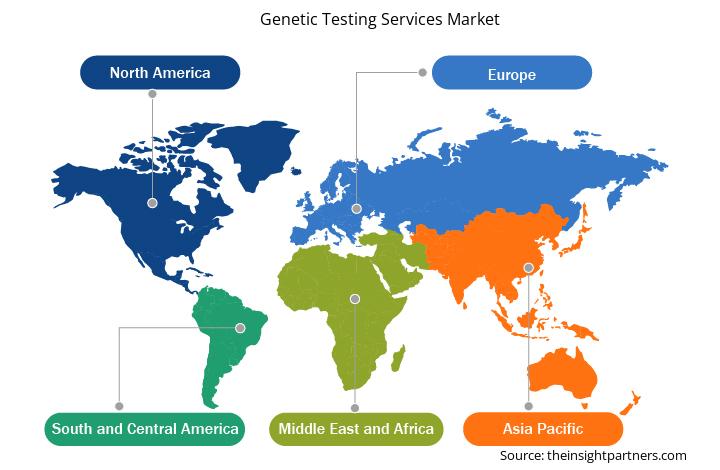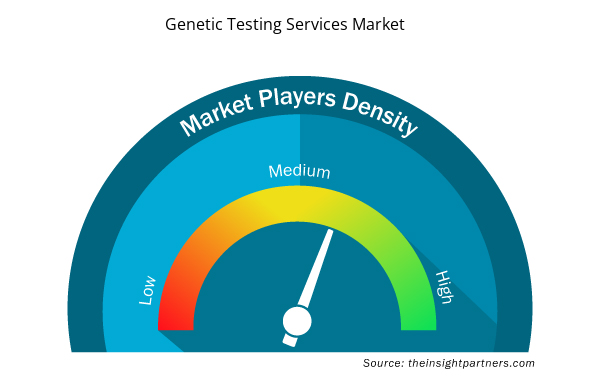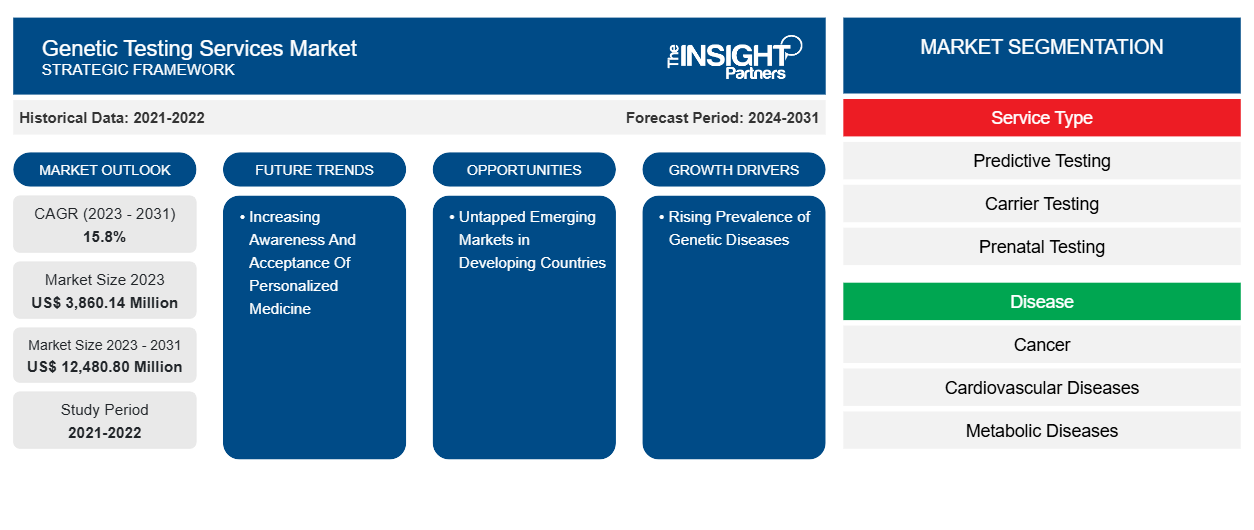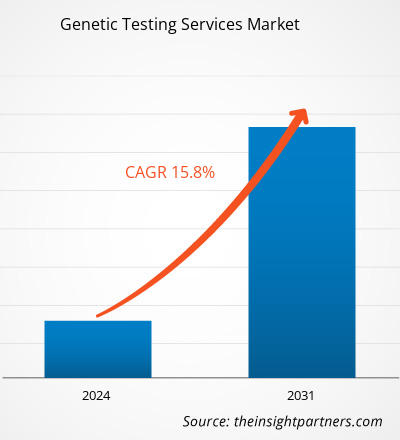预计到 2031 年,基因检测服务市场规模将从 2023 年的 38.6014 亿美元增至 124.808 亿美元。预计 2023-2031 年期间该市场的复合年增长率为15.8%。人工智能驱动的基因检测很可能在未来几年为基因检测服务市场带来新趋势。
基因检测服务市场分析
推动基因检测服务市场发展的因素包括报销计划的推出、对有效治疗选择的需求不断增长以及研究中心实施创新技术。人们对基因检测优势的认识不断提高以及消费者在医疗保健方面的支出增加,正在推动基因检测服务市场的增长。对诊断慢性病的基因检测需求不断增长,支持了参与者投资开发新服务和扩张战略。此外,遗传疾病和癌症发病率的增加对基因检测行业的发展起着至关重要的作用。
基因检测服务市场概览
基因检测是一种医学和科学程序,涉及检查和分析一个人的 DNA,以了解他们的基因构成和遗传信息。由于遗传疾病和癌症的患病率上升,英国的基因检测服务市场预计将大幅增长。例如,根据英国遗传联盟 2021 年的数据,罕见病影响了该国 350 万人;即每 17 人中就有 1 人。根据英国基因人 2023 年的数据,估计每 25 名儿童中就有 1 名患有遗传疾病,这意味着英国每年有 30,000 名婴儿和儿童被新诊断出患有遗传疾病,超过 240 万名儿童和成人患有遗传疾病。
在德国,无创产前检测于 2022 年成为一项公共报销检测。此外,基因组学正在取得重大进展,为增强个性化医疗的可及性铺平了道路。英国建立了支持更多基因组检测可及性的基础设施,包括提供临床服务的全国基因组实验室网络和基因组医学中心。2019 年,政府宣布了英国早期疾病检测研究项目,这是一项重要的新举措,重点关注成人主要慢性疾病,包括所有癌症、心血管疾病和其他此类疾病。
定制此报告以满足您的需求
您可以免费定制任何报告,包括本报告的部分内容、国家级分析、Excel 数据包,以及为初创企业和大学提供优惠和折扣
- 获取此报告的关键市场趋势。这个免费样品将包括数据分析,从市场趋势到估计和预测。
基因检测服务市场驱动因素和机遇
遗传疾病患病率上升有利于市场增长
遗传病的发病率在世界范围内不断上升,严重影响着人们的健康。遗传病表现出许多不常见的症状,而且大多数无法治愈。根据世界卫生组织 (WHO) 2021 年的数据,每 1,000 人中就有 10 人患有单基因疾病,这意味着全世界有 7000 万至 8000 万人患有任何一种单基因疾病。根据全球基因,全世界已发现约 7,000 种已知的罕见疾病和病症,而且每年都有更多疾病被发现。2022 年,美国MJH Life Sciences 的一份报告估计,全世界每年有 300,000 名新生儿患有镰状细胞病,占全球人口的约 5%。 2020 年 6 月,根据瑞士诺华公司 (Novartis AG) 的报告,英国约有 15,000 人患有镰状细胞病,每年有 270 名新生儿被诊断出患有这种疾病。因此,遗传病患病率的上升刺激了对基因检测的需求,进而推动了基因检测服务市场的增长。
发展中国家尚未开发的新兴市场
中国、印度、巴西和墨西哥等新兴国家为市场参与者提供了巨大的增长机会。高收入国家和中低收入国家的遗传服务质量和可用性可能有所不同。例如,在美国、澳大利亚、加拿大、英国和其他欧洲国家,遗传服务非常先进、成熟和广泛。这些服务包括新生儿筛查、携带者识别筛查和产前诊断。然而,在许多高收入国家,在多种环境中提供的遗传服务仍然需要改进评估系统。主要市场参与者正专注于战略和举措,例如协议、合作、伙伴关系和扩张,以改善他们在这些国家的产品可用性、可及性和分销网络,因为这将有助于他们满足日益增长的早期诊断和治疗需求。
中国政府将基因组学列为国家经济和社会发展的“十四五”规划(2016-2020 年)的重要战略领域。2016 年,中国科学院启动了“精准医学”计划,这是一项为期 14 年、耗资 92 亿美元的项目,旨在到 2030 年对超过 1 亿个人类基因组进行测序。2017 年 12 月,中国科技部与一项人类基因组研究项目合作,记录了 10 万人的基因构成。研究人员希望利用九个不同少数民族的基因数据来解码基因内的遗传信息。因此,发展中国家的新兴市场预计将在预测期内为基因检测服务市场的增长提供丰厚的机会。
基因检测服务市场报告细分分析
有助于得出基因检测服务市场分析的关键部分是服务类型、疾病和服务提供商。
- 根据服务类型,基因检测服务市场分为预测检测、携带者检测、产前检测、新生儿筛查、诊断性基因检测等。预测性检测细分市场在 2023 年占据了最大的市场份额,预计在 2023-2031 年期间将实现最高的复合年增长率。
- 根据疾病,基因检测服务市场分为癌症、心血管疾病、代谢疾病和其他疾病。癌症领域在 2023 年占据了最大的市场份额,预计在 2023-2031 年期间将实现最高的复合年增长率。
- 就服务提供商而言,基因检测服务市场分为医院实验室、诊断实验室和其他。医院实验室部门在 2023 年占据了最大的市场份额,预计在 2023-2031 年期间将实现最高的复合年增长率。
基因检测服务市场份额(按地区)分析
基因检测服务市场报告的地理范围主要分为五个区域:北美、亚太地区、欧洲、中东和非洲以及南美和中美。北美在 2023 年占据了相当大的市场份额。近年来,美国和加拿大人口中癌症患者数量的增加、政府资金的增加以及遗传病发病率的上升推动了市场的增长。根据美国政府问责局 2021 年 10 月发布的估计,该国约有 2500 万至 3000 万人患有罕见病;近 50% 的罕见病患者是儿童。罕见病通常是基因突变的结果;据估计,80% 的罕见病是遗传性的。
此外,医疗保健、政府和私人举措越来越重视先进方法的融入,以促进精准医疗,政府和私人机构为基因研究投入大量资金,预计将加速该地区基因检测服务市场的增长。
基因检测服务市场区域洞察
Insight Partners 的分析师已详细解释了预测期内影响基因检测服务市场的区域趋势和因素。本节还讨论了北美、欧洲、亚太地区、中东和非洲以及南美和中美洲的基因检测服务市场细分和地理位置。

- 获取基因检测服务市场的区域特定数据
基因检测服务市场报告范围
| 报告属性 | 细节 |
|---|---|
| 2023 年的市场规模 | 38.6014亿美元 |
| 2031 年市场规模 | 124.808亿美元 |
| 全球复合年增长率(2023 - 2031) | 15.8% |
| 史料 | 2021-2022 |
| 预测期 | 2024-2031 |
| 涵盖的领域 | 按服务类型
|
| 覆盖地区和国家 | 北美
|
| 市场领导者和主要公司简介 |
|
基因检测服务市场参与者密度:了解其对业务动态的影响
基因检测服务市场正在快速增长,这得益于终端用户需求的不断增长,而这些需求又源于消费者偏好的不断变化、技术进步以及对产品优势的认识不断提高等因素。随着需求的增加,企业正在扩大其产品范围,进行创新以满足消费者的需求,并利用新兴趋势,从而进一步推动市场增长。
市场参与者密度是指在特定市场或行业内运营的企业或公司的分布情况。它表明在给定市场空间中,相对于其规模或总市场价值,有多少竞争对手(市场参与者)存在。
在基因检测服务市场运营的主要公司有:
- 美国实验室控股公司
- F.Hoffmann-La Roche Ltd;Illumina, Inc.
- Quest Diagnostics 公司
- 精确科学公司
- NeoGenomics 公司
- 欧陆科技
免责声明:上面列出的公司没有按照任何特定顺序排列。

- 了解基因检测服务市场顶级关键参与者概况
基因检测服务市场新闻和最新发展
基因检测服务市场通过收集一级和二级研究后的定性和定量数据进行评估,其中包括重要的公司出版物、协会数据和数据库。以下列出了基因检测服务市场的一些发展情况:
- GeneDx 增强了其全基因组测序 (WGS) 产品,旨在加速诊断并缩短患者的诊断过程。这些新功能包括快速全基因组测序 (rWGS)、口腔样本和重复扩增的更快周转时间。结合其行业领先的数据集和产品增强功能,GeneDx 提高了全基因组测序在诊断方面的可及性和有效性——最终致力于阻止或减缓常见和罕见疾病的进展。(来源:GeneDx,新闻稿,2024 年 7 月)
- Progenesis 是一家总部位于美国的全球知名基因检测品牌,该公司在新德里开设了第一家基因实验室,并在钦奈开设了一家人工智能 (AI) 和生物信息学数据中心,从而进入印度市场。该品牌与当地医疗保健提供商、生育诊所和医疗从业者合作,扩大其业务范围,让更广泛的受众能够获得先进的基因检测解决方案。(来源:Progenesis,新闻稿,2023 年 12 月)
基因检测服务市场报告覆盖范围和交付成果
“基因检测服务市场规模和预测(2021-2031)”报告对以下领域进行了详细的市场分析:
- 基因检测服务市场规模及全球、区域和国家层面所有主要细分市场的预测
- 基因检测服务市场趋势以及市场动态,如驱动因素、限制因素和关键机遇
- 详细的 PEST 和 SWOT 分析
- 基因检测服务市场分析涵盖主要市场趋势、全球和区域框架、主要参与者、法规和最新市场发展
- 行业格局和竞争分析,涵盖市场集中度、热图分析、知名参与者以及基因检测服务市场的最新发展
- 详细的公司简介
- 历史分析(2 年)、基准年、预测(7 年)及复合年增长率
- PEST 和 SWOT 分析
- 市场规模价值/数量 - 全球、区域、国家
- 行业和竞争格局
- Excel 数据集


- Clear Aligners Market
- Digital Pathology Market
- Clinical Trial Supplies Market
- Medical and Research Grade Collagen Market
- Health Economics and Outcome Research (HEOR) Services Market
- Adaptive Traffic Control System Market
- Hummus Market
- Artwork Management Software Market
- Volumetric Video Market
- Wire Harness Market

Report Coverage
Revenue forecast, Company Analysis, Industry landscape, Growth factors, and Trends

Segment Covered
This text is related
to segments covered.

Regional Scope
North America, Europe, Asia Pacific, Middle East & Africa, South & Central America

Country Scope
This text is related
to country scope.
常见问题
The rising prevalence of genetic diseases and increasing awareness and acceptance of personalized medicines are the most influential factors responsible for the market growth.
Laboratory Corporation of America Holdings; F. Hoffmann-La Roche Ltd; Illumina, Inc.; Quest Diagnostics Inc.; Exact Sciences Corp; NeoGenomics Inc.; Eurofins Scientific; Ambry Genetics; Centogene NV; 23andMe, Inc; Ancestry Genomics Inc.; Gene By Gene Ltd; SIVOTEC BioInformatics LLC; Progenesis; Fulgent Genetics, Inc.; Veritas Intercontinental; and GeneDx, LLC are among the key players operating in the genetic testing services market.
The global genetic testing services market is estimated to register a CAGR of 15.8% during the forecast period.
North America dominated the genetic testing services market in 2023.
The estimated value of the genetic testing services market can reach US$ 12,480.80 million by 2031.
Trends and growth analysis reports related to Life Sciences : READ MORE..
The List of Companies - Genetic Testing Services Market
- Laboratory Corporation of America Holdings
- F. Hoffmann-La Roche Ltd
- Illumina, Inc.
- Quest Diagnostics Incorporated
- Exact Sciences Corp (Genomic Health)
- NeoGenomics Laboratories, Inc.
- Eurofins Scientific
- Ambry Genetics
- Centogene AG
- 23andMe, Inc.
The Insight Partners performs research in 4 major stages: Data Collection & Secondary Research, Primary Research, Data Analysis and Data Triangulation & Final Review.
- Data Collection and Secondary Research:
As a market research and consulting firm operating from a decade, we have published and advised several client across the globe. First step for any study will start with an assessment of currently available data and insights from existing reports. Further, historical and current market information is collected from Investor Presentations, Annual Reports, SEC Filings, etc., and other information related to company’s performance and market positioning are gathered from Paid Databases (Factiva, Hoovers, and Reuters) and various other publications available in public domain.
Several associations trade associates, technical forums, institutes, societies and organization are accessed to gain technical as well as market related insights through their publications such as research papers, blogs and press releases related to the studies are referred to get cues about the market. Further, white papers, journals, magazines, and other news articles published in last 3 years are scrutinized and analyzed to understand the current market trends.
- Primary Research:
The primarily interview analysis comprise of data obtained from industry participants interview and answers to survey questions gathered by in-house primary team.
For primary research, interviews are conducted with industry experts/CEOs/Marketing Managers/VPs/Subject Matter Experts from both demand and supply side to get a 360-degree view of the market. The primary team conducts several interviews based on the complexity of the markets to understand the various market trends and dynamics which makes research more credible and precise.
A typical research interview fulfils the following functions:
- Provides first-hand information on the market size, market trends, growth trends, competitive landscape, and outlook
- Validates and strengthens in-house secondary research findings
- Develops the analysis team’s expertise and market understanding
Primary research involves email interactions and telephone interviews for each market, category, segment, and sub-segment across geographies. The participants who typically take part in such a process include, but are not limited to:
- Industry participants: VPs, business development managers, market intelligence managers and national sales managers
- Outside experts: Valuation experts, research analysts and key opinion leaders specializing in the electronics and semiconductor industry.
Below is the breakup of our primary respondents by company, designation, and region:

Once we receive the confirmation from primary research sources or primary respondents, we finalize the base year market estimation and forecast the data as per the macroeconomic and microeconomic factors assessed during data collection.
- Data Analysis:
Once data is validated through both secondary as well as primary respondents, we finalize the market estimations by hypothesis formulation and factor analysis at regional and country level.
- Macro-Economic Factor Analysis:
We analyse macroeconomic indicators such the gross domestic product (GDP), increase in the demand for goods and services across industries, technological advancement, regional economic growth, governmental policies, the influence of COVID-19, PEST analysis, and other aspects. This analysis aids in setting benchmarks for various nations/regions and approximating market splits. Additionally, the general trend of the aforementioned components aid in determining the market's development possibilities.
- Country Level Data:
Various factors that are especially aligned to the country are taken into account to determine the market size for a certain area and country, including the presence of vendors, such as headquarters and offices, the country's GDP, demand patterns, and industry growth. To comprehend the market dynamics for the nation, a number of growth variables, inhibitors, application areas, and current market trends are researched. The aforementioned elements aid in determining the country's overall market's growth potential.
- Company Profile:
The “Table of Contents” is formulated by listing and analyzing more than 25 - 30 companies operating in the market ecosystem across geographies. However, we profile only 10 companies as a standard practice in our syndicate reports. These 10 companies comprise leading, emerging, and regional players. Nonetheless, our analysis is not restricted to the 10 listed companies, we also analyze other companies present in the market to develop a holistic view and understand the prevailing trends. The “Company Profiles” section in the report covers key facts, business description, products & services, financial information, SWOT analysis, and key developments. The financial information presented is extracted from the annual reports and official documents of the publicly listed companies. Upon collecting the information for the sections of respective companies, we verify them via various primary sources and then compile the data in respective company profiles. The company level information helps us in deriving the base number as well as in forecasting the market size.
- Developing Base Number:
Aggregation of sales statistics (2020-2022) and macro-economic factor, and other secondary and primary research insights are utilized to arrive at base number and related market shares for 2022. The data gaps are identified in this step and relevant market data is analyzed, collected from paid primary interviews or databases. On finalizing the base year market size, forecasts are developed on the basis of macro-economic, industry and market growth factors and company level analysis.
- Data Triangulation and Final Review:
The market findings and base year market size calculations are validated from supply as well as demand side. Demand side validations are based on macro-economic factor analysis and benchmarks for respective regions and countries. In case of supply side validations, revenues of major companies are estimated (in case not available) based on industry benchmark, approximate number of employees, product portfolio, and primary interviews revenues are gathered. Further revenue from target product/service segment is assessed to avoid overshooting of market statistics. In case of heavy deviations between supply and demand side values, all thes steps are repeated to achieve synchronization.
We follow an iterative model, wherein we share our research findings with Subject Matter Experts (SME’s) and Key Opinion Leaders (KOLs) until consensus view of the market is not formulated – this model negates any drastic deviation in the opinions of experts. Only validated and universally acceptable research findings are quoted in our reports.
We have important check points that we use to validate our research findings – which we call – data triangulation, where we validate the information, we generate from secondary sources with primary interviews and then we re-validate with our internal data bases and Subject matter experts. This comprehensive model enables us to deliver high quality, reliable data in shortest possible time.


 获取此报告的免费样本
获取此报告的免费样本